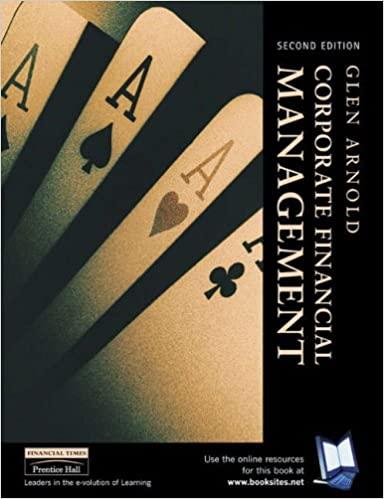Answered step by step
Verified Expert Solution
Question
1 Approved Answer
Show work please without excel starting from E. Thank you. Answers from A to D. Thank you. Plug N Play Inc. is considering financing a

Show work please without excel starting from E. Thank you.

Answers from A to D. Thank you.
Plug N Play Inc. is considering financing a project. The company uses all the three components of capital for raising its fund; debt, preferred and common equity maintaining a target capital structure of 30%, 30%. and 40%. The company's corporate tax is 35%. Based on the above information, answer the following questions: a. If the company would be able to issue new 20-year debt with a cost of 10%, what is the after-tax component cost of the new debt? b. It can issue perpetual preferred stock at a price of $50 a share. The issue is expected to pay a constant annual dividend of $6.50 a share. The floatation cost on the issue is estimated to be 5% dollar per share. What is the component cost of the new preferred stock? c. The earnings, dividends, and stock price of Plug N Play Inc. are expected to grow at a constant rate of 6 percent per year in the future. Its common stock sells for $25 per share, its last dividend was $3.00. Using the DCF approach, what is the cost of common equity? d. Plug N Play's beta is 3. the yield on T-bond is 8 percent, and the expected return on the market is 14 percent. Using the CAPM approach, what is the cost of common equity? e. If the firm uses a 7-percentage point risk premium, using the bond-yield-plus risk premium approach, what is the cost of common equity? f. The financial analyst of the firm suggests that the company's cost of equity should be taken from the average of all possible approaches. On the basis of the results of parts c to e, what would you estimate Plug N' Play's cost of equity be? g. What is Plug N Play's WACC? Expert Answer qwertyu . 44 minutes later Hi, As per the chegg guidelines, in case of multiple sub parts, I need to solve the first four sub parts. a. After tax cost of debt is computed as follows: = cost of debt x (1 - tax rate) x weight of debt = 0.10 x (1 -0.35) x 0.30 = 1.95% b. Component cost of preferred stock is computed as follows: = Dividend / [(Price of stock x (1 - flotation cost) ] x weight of preferred stock = $ 6.50 /[($ 50 x (1 -0.05) ] x 0.30 = ($ 6.50 / $ 47.50) x 0.30 = 4.1053% Approximately c. Cost of common stock is computed as follows: [Dividend x (1 + growth rate)] / Price ] + growth rate = [($ 3x 1.06) / $ 25] + 6% = [ $ 3.18/ $ 25 ] + 6% = 18.72% d. Cost of common equity is computed as follows: = Risk free rate + Beta x (Return on market - risk free rate) = 8% + 3 x (14% -8%) = 8% + 3 x 6% = 26% Please post your remaining questions separately. Please ask in case of any doubts Was this answer helpful? BipoStep by Step Solution
There are 3 Steps involved in it
Step: 1

Get Instant Access to Expert-Tailored Solutions
See step-by-step solutions with expert insights and AI powered tools for academic success
Step: 2

Step: 3

Ace Your Homework with AI
Get the answers you need in no time with our AI-driven, step-by-step assistance
Get Started


